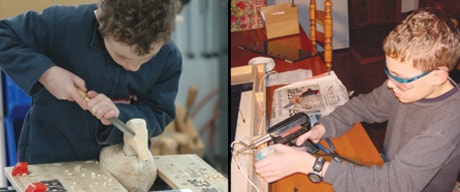In the 1920s, the fields outside my windows resounded with the music of bagpipes and violin.
Ivan Bailey, the teenage boy making the music, taught himself to play, then went on to spend his life building homes, running a farm, single-handedly establishing an entire tourist camp and becoming a rather successful freelance real estate agent. Not blessed with extraordinary intelligence or education, this man did have one creative advantage few of us enjoy today. Boredom. Or at least the potential for boredom.
Ivan grew up in a time free from the ready-made leisure activities of modern life, and this lack of distractions became a powerful motivation for him to become a creator of good things instead of a consumer of someone else’s creativity.
As I slowly learned this man’s story during the last 10 years of his long and productive life, I took special note of how valuable the potential for boredom had been for him.
So I’m here to make a case for intentional boredom as a motivation for kick-starting creative accomplishments around your home. Whether you’re painting a portrait or painting the garage door, you’ll be amazed at what happens if you intentionally turn aside from the unproductive distractions of modern life and allow boredom to get you going.
Over the last 20 years, my kids have helped me see the value of intentional boredom more clearly, too.
When my wife and I started out as parents, we signed our kids up for the usual exhausting roster of after-school activities and clubs, supplemented by metered allotments of “educational” TV. Good parents are supposed to do all this, right? But slowly, as we realized how much down time we were wasting in the car, and how the worldview of our kids was being shaped by people we didn’t even know, we cut back.
First we shut off TV. Then we signed up for fewer activities. And the more we moved in this direction, the more new good things happened in our household. At the moment we do almost no pre-packaged after-school activities outside the home, no commercial TV and no game systems. Sounds draconian, doesn’t it? Even I wonder sometimes if I’ve over done it, then I take note of the results and I feel better.
Between the time our kids get home from school and supper time, I might get to see a new digital portrait drawn on a Wacom tablet, a scale model of the Hindenburg made from corrugated cardboard and bristol board, watch a new video project shot and edited by our oldest guy, or guide my 11-year old as he buys used chainsaws on eBay for repair and resale.
Carving ducks is also one of a handful of woodworking activities that get popular from time to time at our place, too. If you’re looking to cultivate organic creativity in your life, it’s a great alternative to prepackaged, name-brand pastimes.
Boredom offers a push towards creative accomplishment, but there needs to be some focus for that push once you get up off the couch. Without the right tools and supplies at hand, you might as well be playing computer games.
Truth be told, I’ve spent more money on various tools and creative supplies for myself and kids than I ever would have spent on game systems, a wide screen TV, organized activities and club fees.
But having seen both sides of life, I’ve got no regrets at all.
My biggest problem now is where to store the flocks of wooden ducks, fleets of model boats, squadrons of cardboard aircraft and acres of astonishing art that just keeps on coming. I wonder how much space a set of bag pipes takes up?
Steve Maxwell is Canada’s award-winning home improvement expert, and technical editor of Canadian Home Workshop magazine. Sign up for his free homeowner newsletter at www.stevemaxwell.ca
